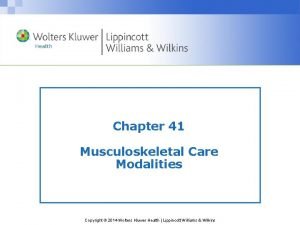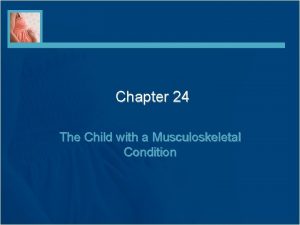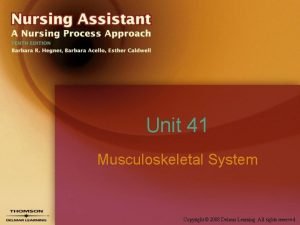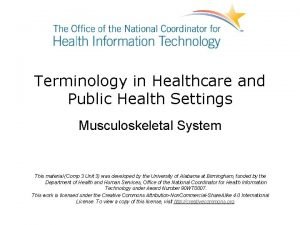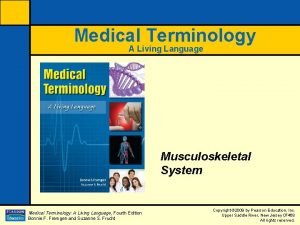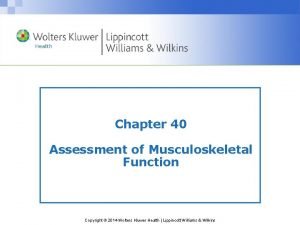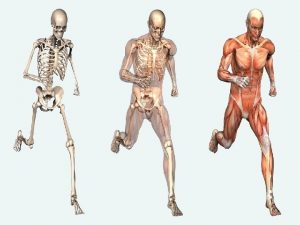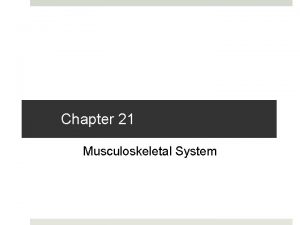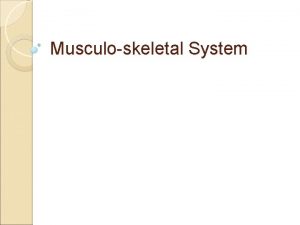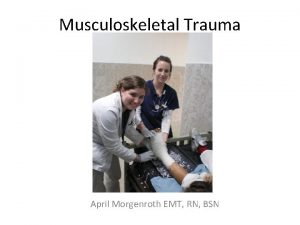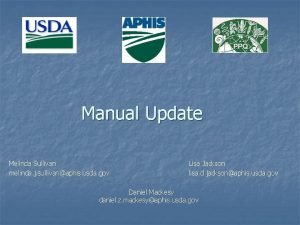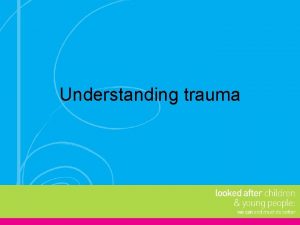Chapter 42 Musculoskeletal Trauma Melinda Woods 14 yo
















- Slides: 16

Chapter 42 Musculoskeletal Trauma

Melinda Woods 14 y/o female

Background • On a hiking trip with her family • Melinda slipped on a wet rock and fell on her right arm. • She immediately began crying with pain. • The skin is intact, but there is an obvious deformity to the right lower arm. • Her mother quickly transports her to the emergency room of the local hospital.

Question • What are the initial actions of the nurse?

Answer • The nurse should immobilize the right lower arm. • Complete a neurovascular assessment of the right hand. • Affected arm should be elevated above the heart on pillows and ice should be applied to decrease the swelling.

Question • The fracture is reduced and immobilized by a cast. • What discharge instructions will the nurse provide to the patient?

Answer • Reduce swelling by keeping the cast elevated on pillows and applying ice to the cast. • Instruct on how to perform a neurovascular assessment and to report any abnormal assessment or increased pain not relieved by analgesic to the primary provider • Instruct patient on the use of pain medication and NSAIDs to manage pain. Use of pain medications should decrease over the first week until they are no longer needed

Cont’d • Instruct on activity level; frequent flexion and extension of fingers, ROM to right shoulder; avoid lifting and twisting or excessive use of the right arm • Instruct on a diet high in protein, vitamin C, and zinc to promote healing • Follow up with primary provider as instructed

Cont’d • The nurse should have the patient and parent repeat the instructions in their own words to verify understanding. • A copy of the discharge instructions should be given to the parent.

Alan Dean 42 y/o male

Scenario • Admitted to the medical-surgical unit after a left below-knee amputation (BKA) for a traumatic injury at an industrial job. • The patient has two Jackson--Pratt drains, and a removable rigid dressing was placed over the soft dressing after surgery. • There is a large tourniquet at the bedside. • There also ace wraps and bandaging supplies at the bedside.

Question • What is the rationale for the removable rigid dressing, and what is the role of the nurse when caring for the patient with this type of dressing?

Answer • The removable rigid dressing is placed over the soft dressing to control swelling, to prevent joint flexion contracture, to help shape the residual limb, and to protect the limb from trauma when transferring the patient. • The nurse will assess the patient’s vital signs, JP drains, and the femoral pulse of the left leg and compare the pulse with the right leg. • The nurse will assess the wound in several days when the surgeon removes the removable rigid dressing, and the surgeon will replace the dressing if no complications are noted. •

Question • On what areas should nursing care for the patient in this case study focus?

Answer • Monitor and provide interventions to maintain adequate tissue perfusion to the residual limb. The residual limb should be gently handled. The residual limb should not be elevated • Monitor fluid and electrolyte balance and provide ordered interventions to correct imbalances • Achieve adequate pain relief as reported by the patient. Phantom pain is a common occurrence. The patient should be medicated for phantom pain

Cont’d • Provide strict sterile asepsis when caring for the wound, and report abnormal findings immediately • Instruct patient and family on care of the residual limb • Encourage patient to vent feelings about the change in body image, and encourage the patient to look at, touch, and participate in the care of the limb • Instruct and promote achievement of independence in self-care • Reinforce rehabilitation to achieve physical mobility using prosthesis
 The musculoskeletal system chapter 21
The musculoskeletal system chapter 21 Chapter 6 musculoskeletal system
Chapter 6 musculoskeletal system Chapter 15 musculoskeletal system step by step
Chapter 15 musculoskeletal system step by step Chapter 41 musculoskeletal care modalities
Chapter 41 musculoskeletal care modalities Chapter 24 the child with a musculoskeletal condition
Chapter 24 the child with a musculoskeletal condition Musculoskeletal system
Musculoskeletal system Unit 41 musculoskeletal system
Unit 41 musculoskeletal system Musculoskeletal system
Musculoskeletal system Icd 10 code for musculoskeletal spasm
Icd 10 code for musculoskeletal spasm Kode icd 10 dislocation genu
Kode icd 10 dislocation genu Musculoskeletal fitness
Musculoskeletal fitness Work related musculoskeletal disorders definition
Work related musculoskeletal disorders definition Musculoskeletal pronounce
Musculoskeletal pronounce Musculoskeletal system medical terminology
Musculoskeletal system medical terminology Diseases of the musculoskeletal system
Diseases of the musculoskeletal system Assessment of the musculoskeletal system
Assessment of the musculoskeletal system Assessment of the musculoskeletal system
Assessment of the musculoskeletal system



